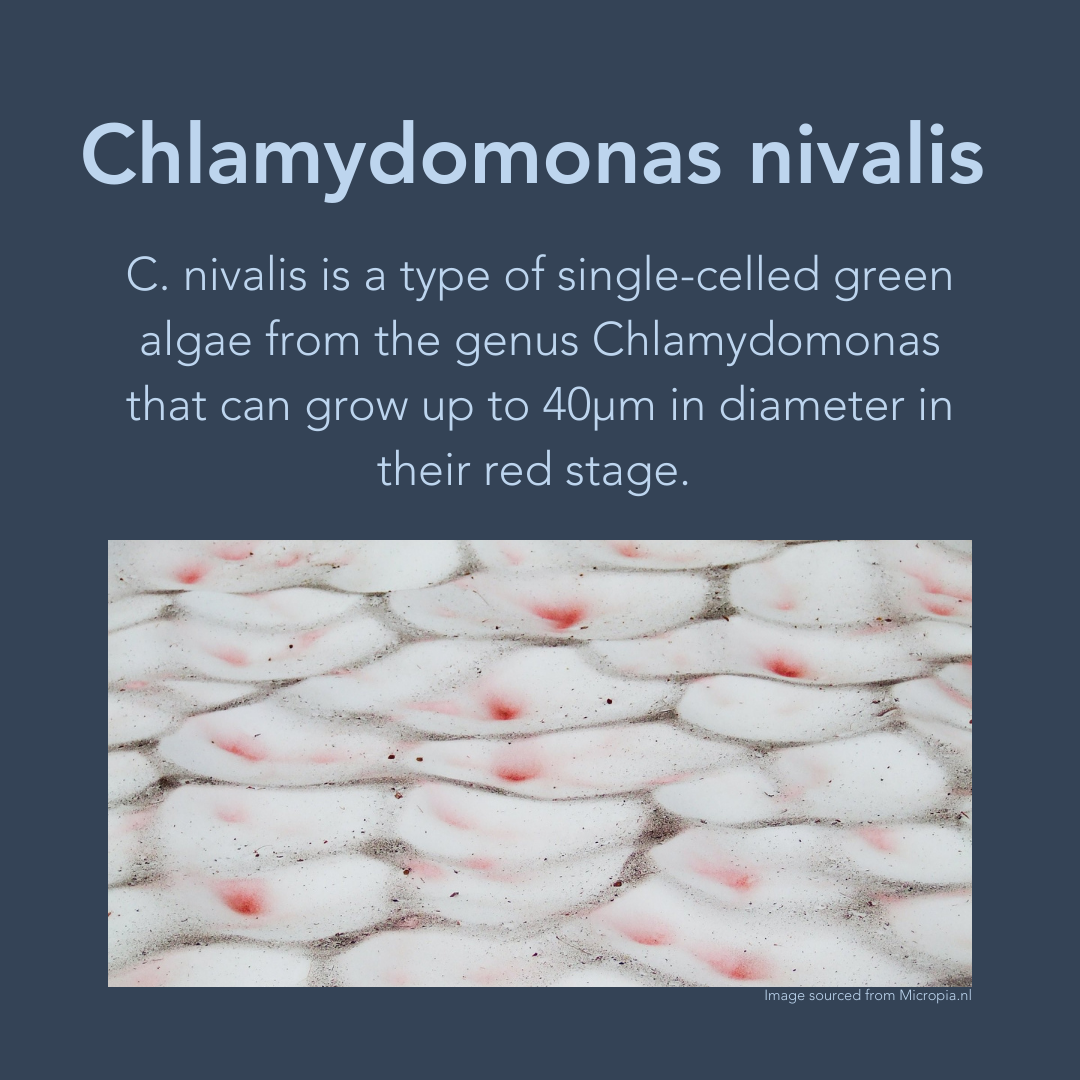Get to Know Watermelon Snow
Throughout the polar regions and high-up on mountain tops, there have been reports of pink, orange, and red patches in the snow. This phenomenon is being referred to as “watermelon snow” or “blood snow”. Yet, summer fruits and blood stains are not the culprit behind these unconventional sightings. Rather, a microscopically closer look is needed to uncover what is causing these discolorations: the organism behind the so-called watermelon snow is a species of green snow algae called Chlamydomonas nivalis.
tops, there have been reports of pink, orange, and red patches in the snow. This phenomenon is being referred to as “watermelon snow” or “blood snow”. Yet, summer fruits and blood stains are not the culprit behind these unconventional sightings. Rather, a microscopically closer look is needed to uncover what is causing these discolorations: the organism behind the so-called watermelon snow is a species of green snow algae called Chlamydomonas nivalis.
 Although relatively little is known about snow algae, C. nivalis has received considerable attention as it is used as a model organism to investigate cold adaptation. This species is classified as a psychrophile, which means it is able to thrive and survive in extreme cold conditions, hence why it can be found at near-freezing temperatures. In fact, C. nivalis has a myriad of adaptations which allows it to flourish despite the environmental stressors associated with harsh polar environments. Moreover, C. nivalis can be characterized by its two life cycles. In the winter, they exist as red spherical cysts beneath the snow, and in late spring/early summer, they become green motile cells in the melting snow. The summer, however, brings about a new set of challenges including high irradiation, or high exposure to radiation, from the sun. To protect itself from dehydration, C. nivalis can accumulate carotenoids to shield from excess exposure to UV radiation. As a result, the green pigmentation of C. nivalis, caused by chlorophyll, shifts to red as carotenoids accumulate.
Although relatively little is known about snow algae, C. nivalis has received considerable attention as it is used as a model organism to investigate cold adaptation. This species is classified as a psychrophile, which means it is able to thrive and survive in extreme cold conditions, hence why it can be found at near-freezing temperatures. In fact, C. nivalis has a myriad of adaptations which allows it to flourish despite the environmental stressors associated with harsh polar environments. Moreover, C. nivalis can be characterized by its two life cycles. In the winter, they exist as red spherical cysts beneath the snow, and in late spring/early summer, they become green motile cells in the melting snow. The summer, however, brings about a new set of challenges including high irradiation, or high exposure to radiation, from the sun. To protect itself from dehydration, C. nivalis can accumulate carotenoids to shield from excess exposure to UV radiation. As a result, the green pigmentation of C. nivalis, caused by chlorophyll, shifts to red as carotenoids accumulate.


Despite the wholesome name given to this phenomenon and its perceivable innocuousness, watermelon snow and its implications in global warming should not be overlooked. As C. nivalis expresses a greater number of carotenoids in response to high levels of irradiation, this darker pigmentation has negative consequences on the albedo of snow. Albedo is how much light is reflected by a surface, with high albedo meaning high reflection, and low albedo meaning low reflection. Thus, high expression of carotenoids, which in turn darken the snow, can reduce the albedo of snow. With less sunlight being reflected from the surface, snow and ice melt faster, which ultimately can accelerate glacier retreat. In fact, watermelon snow has been found to decrease surface albedo by up to 20%, dubbed the “bio-albedo” effect.
Thus, there is precedent for scientists to further investigate ice and snow-algae species, as these tiny organisms have a big impact on albedo. Some scientists have even suggested that the “bio-albedo” effect be considered in climate models. As the Arctic warms at an unprecedented rate, we must look to all corners of life, no matter how small, to prevent further change in this unique and vast environment.
Julia Macpherson, Science Communications Coordinator
References
Stefanie Lutz and others, Variations of algal communities cause darkening of a Greenland glacier, FEMS Microbiology Ecology, Volume 89, Issue 2, August 2014, Pages 402–414, https://doi.org/10.1111/1574-6941.12351
Lutz, S., Anesio, A., Raiswell, R. et al. The biogeography of red snow microbiomes and their role in melting arctic glaciers. Nat Commun 7, 11968 (2016). https://doi.org/10.1038/ncomms11968
Peng Z, Liu G, Huang K. Cold Adaptation Mechanisms of a Snow Alga Chlamydomonas nivalis During Temperature Fluctuations. Front Microbiol. 2021 Jan 11;11:611080. doi: 10.3389/fmicb.2020.611080. PMID: 33584575; PMCID: PMC7874021.
Lutz, S., Anesio, A. M., Field, K. J., & Benning, L. G. (2015). Integrated ‘Omics’, targeted metabolite and single-cell analyses of Arctic snow algae functionality and adaptability. Frontiers in Microbiology, 6. https://doi.org/10.3389/fmicb.2015.01323